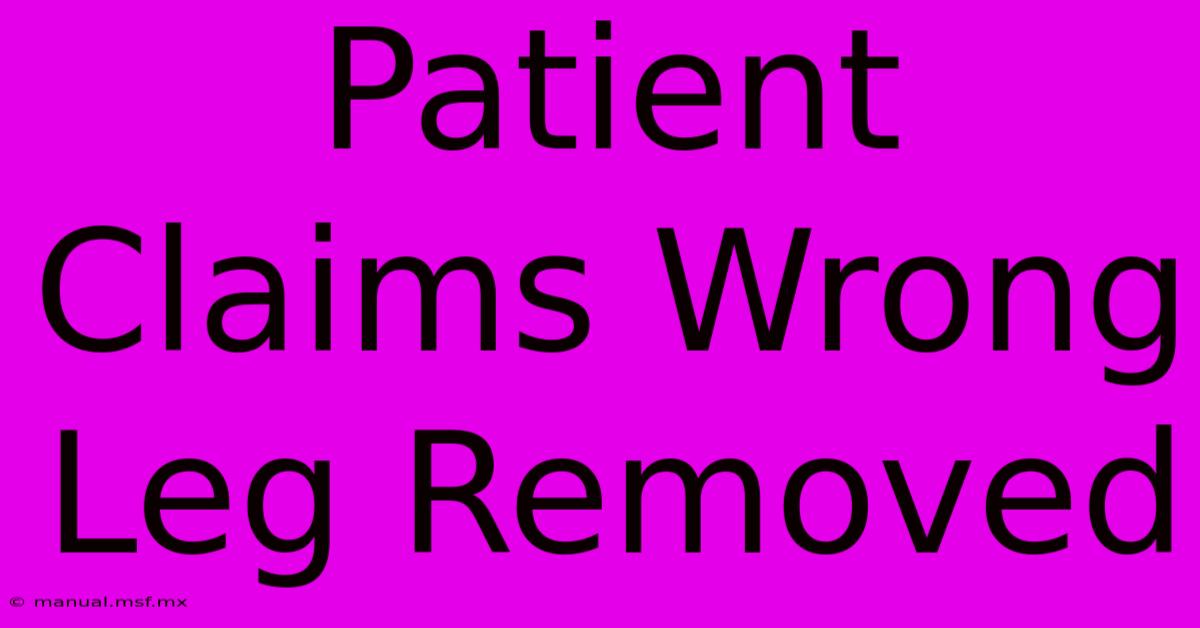Patient Claims Wrong Leg Removed

Discover more detailed and exciting information on our website. Click the link below to start your adventure: Visit Best Website. Don't miss out!
Table of Contents
The Shocking Reality of Medical Errors: When the Wrong Leg is Removed
Have you ever wondered if medical mistakes happen more often than we think? The unfortunate reality is that medical errors, including serious surgical blunders like removing the wrong limb, are far more common than many people realize. This horrifying situation, often referred to as a "wrong-site surgery," raises profound questions about patient safety and the accountability of healthcare professionals.
Editor Note: "Patient Claims Wrong Leg Removed" highlights a critical issue impacting patient safety and trust in healthcare.
This topic is crucial because it exposes the vulnerability of patients during medical procedures and the potential for catastrophic consequences when errors occur. It also underscores the need for robust safety protocols and clear communication within the healthcare system.
This article delves into the complexities of this disturbing issue, analyzing the factors contributing to such errors, examining the legal ramifications, and exploring potential solutions to prevent future tragedies.
Analysis: To understand the alarming reality of "wrong-site surgery," we conducted extensive research, analyzing medical journals, legal databases, and patient advocacy groups. This investigation shed light on the underlying causes, the emotional and physical impact on patients, and the ongoing efforts to improve patient safety.
Key Insights into "Wrong Leg Removal"
| Insight | Explanation |
|---|---|
| Human Error is a Major Factor | Mistakes are often attributed to fatigue, distractions, and poor communication within medical teams. |
| Lack of Robust Protocols and Checklists | The absence of standardized procedures and comprehensive verification practices can contribute to errors. |
| Inadequate Patient Identification | Inaccurate patient information and miscommunication can lead to the wrong patient receiving a procedure. |
| Poor Communication and Collaboration | A breakdown in communication between medical professionals can lead to misunderstanding and misinterpretations. |
| Complex Surgical Procedures | The intricacy of some surgeries increases the risk of errors, especially when multiple teams are involved. |
| Systemic Issues | Underlying problems with the healthcare system, such as staffing shortages or inadequate training, can play a role. |
Wrong Leg Removal: Unraveling the Complexity
Surgical Errors: Wrong-site surgeries are the most extreme form of medical errors, often leading to permanent disability and profound psychological trauma. While such cases may seem unimaginable, they highlight the critical need for robust safety protocols and a culture of vigilance within the healthcare system.
Patient Identification and Communication: Accurate patient identification is fundamental to preventing wrong-site surgery. Clear, standardized procedures, such as double-checking patient information, marking the surgical site, and using a time-out protocol, are crucial. Effective communication between all medical professionals involved in the surgical process is also essential.
Legal Implications: Patients who experience a "wrong-site surgery" have legal recourse. Depending on the specific circumstances and jurisdiction, they can pursue medical malpractice claims against the healthcare providers, hospital, or other involved parties. Successful claims often require demonstrating negligence, a breach of the standard of care, and a direct link between the error and the patient's injuries.
Beyond the Legal Aftermath: While legal redress can offer some compensation for the physical and emotional harm, it cannot fully address the profound impact of a wrong-site surgery. Patients often experience significant psychological distress, anxiety, and trust issues with the healthcare system.
Prevention and Improvement:
Implementing robust safety protocols: Standardized procedures, checklists, and time-out protocols can significantly reduce the likelihood of errors.
Enhancing communication and collaboration: Clear communication, open dialogue, and teamwork among medical professionals are essential to prevent misinterpretations and ensure all parties are on the same page.
Focusing on patient-centered care: Putting the patient at the center of decision-making, encouraging them to ask questions and voice concerns, and actively involving them in their treatment plan can foster trust and safety.
Embracing technology: Electronic medical records and other digital tools can improve communication, streamline processes, and reduce the risk of human error.
The Journey Towards Safer Healthcare:
"Patient Claims Wrong Leg Removed" is not just a shocking headline; it's a stark reminder of the ongoing battle for patient safety within the healthcare system. While human error can never be completely eliminated, the implementation of robust protocols, a commitment to transparency and accountability, and a focus on patient-centered care are crucial steps in minimizing the risk of medical mistakes.
This journey towards safer healthcare requires a collective effort from healthcare professionals, institutions, and patients alike. Only by embracing these fundamental principles can we build a healthcare system that prioritizes patient well-being and minimizes the occurrence of such devastating errors.

Thank you for visiting our website wich cover about Patient Claims Wrong Leg Removed. We hope the information provided has been useful to you. Feel free to contact us if you have any questions or need further assistance. See you next time and dont miss to bookmark.
Also read the following articles
| Article Title | Date |
|---|---|
| Tyson Vs Paul Direct Heure Chaine | Nov 14, 2024 |
| Cava Stock Up Today Reasons Explained | Nov 14, 2024 |
| John Stamos Supports Dave Couliers Cancer Battle | Nov 14, 2024 |
| The Office Star John Krasinski Ist Sexiest Man Alive | Nov 14, 2024 |
| Whoopi Goldbergs Work Statement Sparks Debate | Nov 14, 2024 |
| Trump Picks Gaetz For Attorney General | Nov 14, 2024 |
| Quem Sai Enquete A Fazenda 16 Flora Gizelly Vanessa | Nov 14, 2024 |
| Niger Soudan Match En Direct Chaine Et Heure | Nov 14, 2024 |
| Testspiel St Pauli Trifft Auf Braunschweig | Nov 14, 2024 |
| Exclusive Sneakers Cavs Players Woj Tribute | Nov 14, 2024 |
